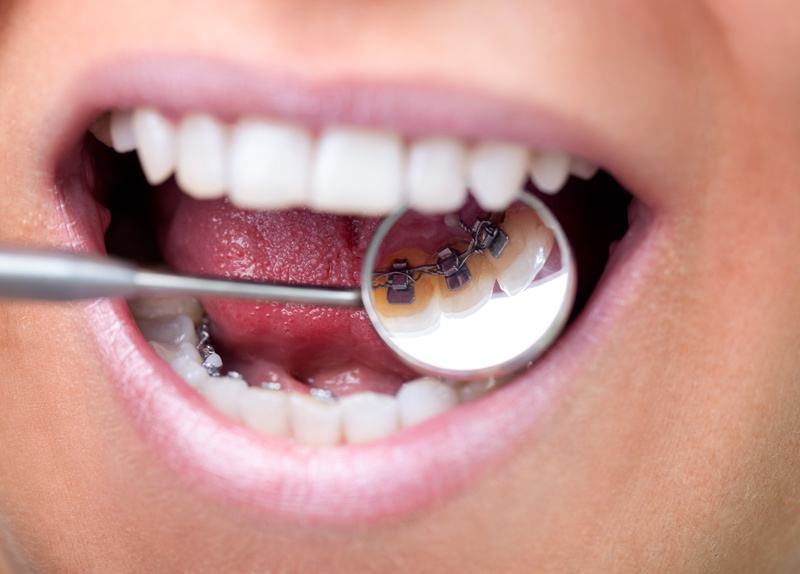
Dental veneers, thin shells enhancing teeth appearance, are attached in a multi-step process. Initially, enamel is gently removed under local anesthesia for veneer placement space. Impressions follow, forming custom veneers crafted by skilled technicians. The final step involves bonding the veneers to the teeth using a strong adhesive, creating a seamlessly transformed and natural-looking smile. This cosmetic dentistry procedure, offering a confidence boost, showcases the meticulous artistry of modern dentistry.

How Are Dental Veneers Attached?
Dental veneers are a popular cosmetic dental treatment that can transform the appearance of your smile. They are thin shells of porcelain or composite resin that are custom-made to fit over the front surface of your teeth. Veneers can be used to correct a variety of dental issues, including discoloration, chipped or broken teeth, and gaps between teeth. But how exactly are dental veneers attached? Let’s take a closer look.
The Process of Attaching Dental Veneers
Attaching dental veneers is a multi-step process that requires the expertise of a skilled dentist. Here’s a breakdown of the steps involved:
1. Consultation and Treatment Planning
The first step in getting dental veneers is to schedule a consultation with your dentist. During this appointment, you will discuss your goals and expectations for the treatment. Your dentist will also examine your teeth and determine if veneers are the right option for you. If both you and your dentist decide that veneers are a suitable choice, the treatment plan will be created.
2. Tooth Preparation
Before attaching the veneers, your dentist will need to prepare your teeth. This involves removing a small amount of enamel from the front surface of the teeth that will be covered by the veneers. This step is necessary to ensure a proper fit and to create space for the veneers to be bonded securely.
3. Impression and Temporary Veneers
After the tooth preparation, your dentist will take impressions of your teeth. These impressions will be sent to a dental laboratory, where your custom veneers will be fabricated. In the meantime, your dentist may place temporary veneers on your teeth to protect them and to give you an idea of how your final smile will look.
4. Bonding the Veneers
Once your permanent veneers are ready, your dentist will remove the temporary veneers and clean your teeth. The veneers will then be carefully placed on your teeth, and cemented on to the teeth. Your dentist may make minor adjustments to ensure a perfect fit. Once both you and your dentist are satisfied, the veneers will be permanently bonded to your teeth using a special dental adhesive.
Benefits of Dental Veneers
Now that we’ve discussed how dental veneers are attached, let’s explore some of the benefits they offer:
1. Improved Appearance
Dental veneers can dramatically improve the appearance of your smile. They can cover up stains, discoloration, and other imperfections, giving you a brighter, more even smile.
2. Natural-Looking Results
Veneers are designed to mimic the natural appearance of teeth, so they blend seamlessly with your existing teeth. They are also customizable, allowing you to choose the shape, size, and color that best suits your preferences.
3. Long-Lasting Solution
With proper care, dental veneers can last for many years. They are resistant to staining and are durable enough to withstand normal biting and chewing forces.
4. Minimally Invasive
Compared to other cosmetic dental treatments, the process of attaching dental veneers is minimally invasive. Only a small amount of enamel is removed during the tooth preparation stage, making it a conservative option.
In conclusion, dental veneers are attached through a meticulous process that involves consultation, tooth preparation, impression-taking, and bonding. These thin shells provide a range of benefits, including improved appearance, natural-looking results, longevity, and minimal invasiveness. If you’re considering enhancing your smile, dental veneers may be the perfect solution for you. Schedule a consultation with your dentist to learn more about this transformative cosmetic dental treatment.
Key Takeaways: How Are Dental Veneers Attached?
- Dental veneers are attached to the front surface of your teeth.
- The dentist will first remove a small amount of enamel from your teeth.
- A mold of your teeth will be taken to create custom veneers.
- The veneers are then bonded to your teeth using a special dental adhesive.
- After attachment, the dentist will ensure proper fit and make any necessary adjustments.
Frequently Asked Questions
1. How are dental veneers attached?
Dental veneers are attached to the teeth using a multi-step process. The first step is to prepare the teeth by removing a small amount of enamel from the front surface. This is done to ensure that the veneers can be securely bonded to the teeth. Next, an impression of the teeth is taken to create custom-made veneers that fit perfectly. Temporary veneers may be placed while the permanent ones are being created.
Once the permanent veneers are ready, the dentist will carefully bond them to the teeth using a dental adhesive. The veneers are then adjusted for fit and bite alignment. Finally, a curing light is used to harden the adhesive and ensure a strong bond between the veneers and the teeth.
2. How long does the process of attaching dental veneers take?
The process of attaching dental veneers typically takes two to three appointments. During the first appointment, the teeth are prepared and impressions are taken. Temporary veneers may be placed at this time. The second appointment involves bonding the permanent veneers to the teeth. The dentist will ensure proper fit and alignment before finalizing the bond. In some cases, a third appointment may be necessary for additional adjustments or refinements.
Each appointment usually takes about one to two hours, depending on the complexity of the case. It is important to note that the process may vary depending on the individual’s specific needs and the dentist’s treatment plan.
3. Is the process of attaching dental veneers painful?
The process of attaching dental veneers is generally not painful. Before the procedure, the dentist will administer a local anesthetic to numb the area and ensure the patient’s comfort. This helps to minimize any discomfort or sensitivity during the preparation and bonding process. Some individuals may experience slight sensitivity or soreness in the gums following the procedure, but this is usually temporary and can be managed with over-the-counter pain medication.
If a patient has dental anxiety or a strong gag reflex, the dentist may offer additional sedation options to help them relax during the procedure. It is important to communicate any concerns or preferences with the dentist beforehand to ensure a comfortable experience.
4. How long do dental veneers last?
Dental veneers can last for many years with proper care and maintenance. On average, veneers can last between 10 to 15 years. However, their lifespan can vary depending on factors such as oral hygiene practices, eating habits, and the overall health of the teeth and gums. It is important to maintain regular dental check-ups and follow the dentist’s recommendations for oral care to ensure the longevity of veneers.
In some cases, veneers may need to be replaced or repaired if they become damaged or worn over time. This can typically be done without the need for extensive tooth preparation, as the existing veneers can be removed and replaced with new ones.
5. Can dental veneers be removed?
Dental veneers are designed to be a long-term solution for improving the appearance of teeth. However, they can be removed if necessary. The removal process involves carefully separating the veneers from the teeth using specialized dental instruments. This should only be done by a qualified dentist to avoid causing damage to the underlying tooth structure.
If a patient wishes to remove their veneers, it is important to discuss their concerns with the dentist. The dentist can evaluate the condition of the veneers and provide guidance on the best course of action. It is important to note that once veneers are removed, the natural teeth may be slightly altered in shape or appearance, and alternative treatment options may be considered.
Veneers Dental Procedure at Cosmetic Dental Associates in San Antonio, TX
Final Summary: How Are Dental Veneers Attached?
So, there you have it! We’ve explored the fascinating world of dental veneers and how they are attached to your teeth. From the initial consultation to the final bonding process, the journey to a perfect smile is truly a blend of science and artistry.
Throughout this article, we’ve learned that dental veneers are thin, custom-made shells that are carefully placed on the front surface of your teeth to improve their appearance. The attachment process involves several steps, including tooth preparation, impression taking, veneer fabrication, and finally, bonding the veneers to your teeth using a strong dental adhesive.
By following these steps, dentists ensure that the veneers are securely attached and blend seamlessly with your natural teeth. The result? A beautiful, radiant smile that boosts your confidence and leaves a lasting impression.
In conclusion, dental veneers offer a transformative solution for those looking to enhance their smiles. Whether you’re seeking to correct discoloration, chips, or gaps, veneers can provide a natural-looking and long-lasting solution. So, if you’ve been dreaming of that perfect smile, don’t hesitate to consult with a dental professional to explore the possibility of dental veneers. Remember, a confident smile is just a veneer away!
Call or Book appointment online
:Ace Dental Care Alpharetta office: 678-562-1555 - Book Now
Ace Dental Care Norcross office: 770-806-1255 - Book Now
Disclaimer
This blog post was generated by artificial intelligence. The content of this post may not be accurate or complete, and should not be relied upon as a substitute for professional advice. If you have any questions about the content of this post, please contact us.
We are constantly working to improve the accuracy and quality of our AI-generated content. However, there may still be errors or inaccuracies. We apologize for any inconvenience this may cause.





